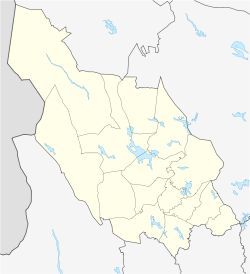Torsång
| Torsång | |
|---|---|
 | |
 Torsång  Torsång | |
| Coordinates: 60°28′N 15°34′E / 60.467°N 15.567°ECoordinates: 60°28′N 15°34′E / 60.467°N 15.567°E | |
| Country | Sweden |
| Province | Dalarna |
| County | Dalarna County |
| Municipality | Borlänge Municipality |
| Area[1] | |
| • Total | 1.08 km2 (0.42 sq mi) |
| Population (31 December 2010)[1] | |
| • Total | 666 |
| • Density | 616/km2 (1,600/sq mi) |
| Time zone | CET (UTC+1) |
| • Summer (DST) | CEST (UTC+2) |
Torsång is a locality situated in Borlänge Municipality, Dalarna County, Sweden with 666 inhabitants in 2010.[1] Situated on the lakes Runnsjön, Osjön and river Dalälven, which are connected with canal Lillälven.
Torsång Court District, or Torsångs tingslag, was a district of Dalarna in Sweden. The court district (tingslag) served as the basic division of the rural areas in Dalarna, except for one district that was a hundred (härad). The entire province had once been a single hundred, called Dala hundare.
History
Swedish (then future) king Gustav I (Gustav Vasa) passed through the place year 1520, while fugitive from Danish mercenaries. Memory stone was erected to memorize this important event of the Swedish history and can still be seen in Torsång's open-air museum.

References
- 1 2 3 "Tätorternas landareal, folkmängd och invånare per km2 2005 och 2010" (in Swedish). Statistics Sweden. 14 December 2011. Archived from the original on 10 January 2012. Retrieved 10 January 2012.
| Wikimedia Commons has media related to Torsång. |